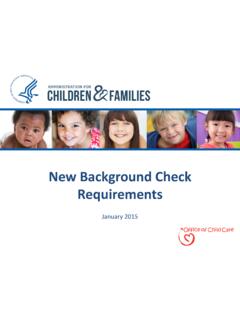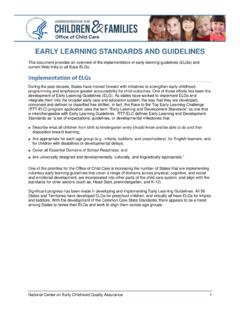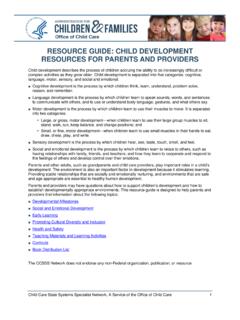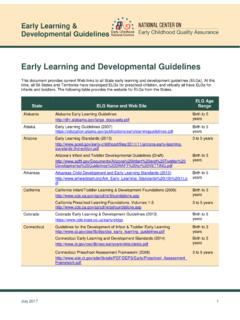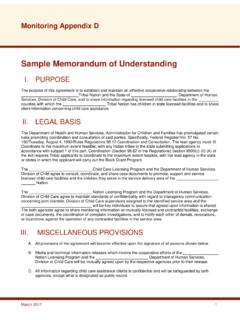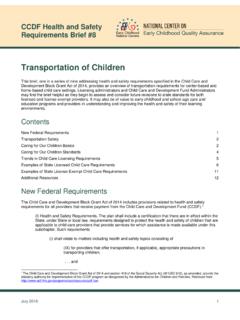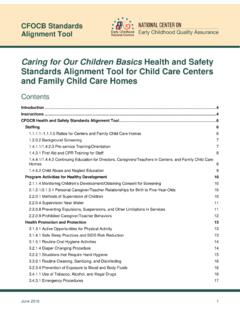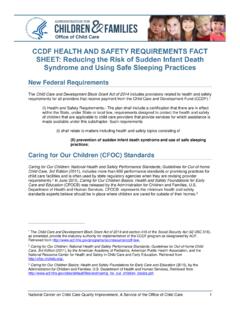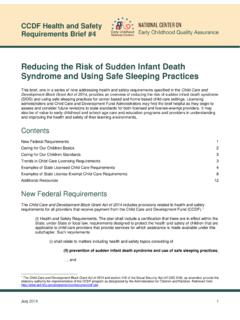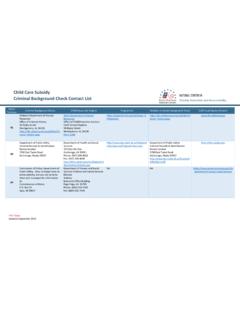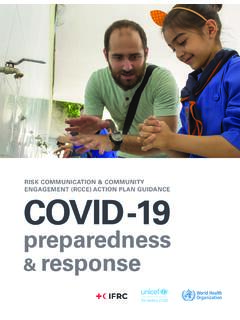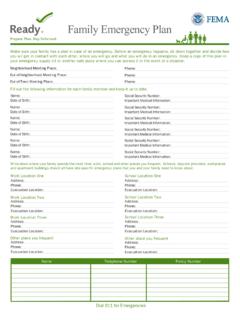Transcription of Emergency Preparedness Manual for Early Childhood …
1 Department of Health and Human Services Administration for Children and FamiliesOffice of Head Department of Health and Human Services Administration for Children and Families Office of Head StartEmergency Preparedness Manualfor Early Childhood Programs National Center on Early Childhood Health and Wellness Toll-free phone: 888-227-5125 E-mail: 2 3 How to Use This ManualChapter 1: Introduction 5 Key Terms 6 Emergency Preparedness Self-Assessment 7 What Types of Emergencies Could You Experience? Chapter 2: Preparedness 8 What Is Preparedness ? 8 National Requirements and Recommendations for Child Care Emergency Preparedness 9 Whom to Consult in Your Community When Making Your Plan (Tip Sheet)10 Whom to Contact in Your Community During an Emergency (Worksheet)11 Know Your Communication Equipment Needs12 Establishing Your Communication Procedures (Worksheet)13 Preparedness : Making Your Emergency Response Plan (Tip Sheet)14 Evacuation Response in Centers and (Worksheet)18 Evacuation Response in Family Child Care Homes21 How to Build an Emergency Kit22 Practice Your Plan22 Reunification Procedures23 Reunification Procedures (Worksheet)24 Child Information Sheets27 Mitigation ChecklistChapter 3: Response29 What Is Response?
2 30 What Is the Appropriate Response? Standard Response Plan Chart Response Procedure Checklists 31 Response Checklists for Center-Based Programs34 Evacuation Procedure Checklist for Family Child Care Homes37 Practice, Review, Revise Framework38 Practice, Review, Revise Worksheet40 Response ScenariosChapter 4: Recovery46 What Is Recovery?46 Reunification46 Damage and Needs Assessment47 Continuation of Services47 Mental Health and Emotional Needs48 Recovery ResourcesChapter 5: Conclusion and Resources49 Additional Resources to Help Programs Prepare, Recover, and Respond50 Glossary of TermsCONTENTSN ational Center on Early Childhood Health and Wellness Toll-free phone: 888-227-5125 E-mail: 3 This Manual is intended to assist Early Childhood education programs in making a plan that will help keep their program, center, or home safe during an Emergency . The Manual is designed to be a workbook-style document that includes information about Emergency Preparedness as well as corresponding worksheets that allow you to customize an Emergency plan for your program, center, or home.
3 As you go through the Manual , consider the points below as a way to guide you through the process of creating your Emergency Preparedness plan. bComplete the Emergency Preparedness Self-Assessment questionnaire (p. 6) to determine the steps your program, center, or home may need to take to develop a comprehensive Emergency - Preparedness plan. bUse the What Types of Emergencies Could You Experience? checklist (p. 7) to help ensure that you are prepared for all possible emergencies. bLearn who in your community can help you make and practice your Emergency plan with the Whom to Consult in Your Community worksheet ( ). bEstablish your communications procedures during the Preparedness phase with the Establishing Your Communication Procedures worksheet (p. 12).HOW TO USE THIS Manual bDesignate staff responsibilities and determine evacuation sites and Emergency response in the Preparedness phase with the Making Your Emergency Response Plan worksheet (pgs.)
4 14-20). bMake your Emergency kit using the How to Build an Emergency Kit worksheet (p. 21). bUse the Mitigation Checklist (pgs. 27-28) to consider changes that could be made to reduce damage or injuries in your program. bFollow the relevant Procedure Checklist for Early Childhood education programs (pgs. 31-36) to ensure each part of your Emergency response is completed. 1. After practicing your Emergency procedures, follow the Practice, Review, and Revise Framework (pgs. 38-39) to reflect on how to improve your procedures in the Find resources focusing on how to begin the process of returning your program to normalcy for children, families, and staff after an complete plan includes: bCommunication procedures with first responders, staff, and families bResponse options for each type of Emergency you may experience Evacuation: routes, gathering sites, means of evacuating ( , walking, cribs, car seats, wheelchairs) Shelter in place: safest place to shelter for the given Emergency , how to protect yourself and children Lockdown: safest place to lock down in a classroom or home, how to secure a room bReunification procedures and Emergency contacts for each childNational Center on Early Childhood Health and Wellness Toll-free phone: 888-227-5125 E-mail: 4 Emergencies often happen suddenly and can be devastating to programs and communities.
5 Emergency Preparedness is the process of taking steps to ensure your Early Childhood education program is safe before, during, and after an Emergency . Whether a natural disaster such as a tornado hits or a man-made Emergency such as the appearance of a violent intruder occurs, Early Childhood educators need to know how to respond quickly and appropriately to situations that could happen in their program, center, or home. The purpose of this Manual is to help child care providers and Head Start staff create an Emergency Preparedness plan specific to their program, center, or Childhood education programs play an important role in supporting children and families in their local communities before, during, and after an Emergency through three phases of Emergency management: bPreparedness Takes place before an Emergency . It includes being informed about any likely emergencies in your area; mitigating any existing concerns at your facility that could make an Emergency worse; making plans to respond to emergencies before they happen; and building, maintaining, and updating supply kits you will take or keep with you during an Emergency .
6 BResponse Begins the moment you are alerted to an impending Emergency and continues as the Emergency occurs. bRecovery Happens as soon as the Emergency is over, when efforts are focused on food, water, shelter, safety, and the emotional needs of those affected. Recovery is also the process of rebuilding your program and returning to normalcy after an Emergency , which is why it can last hours, weeks, months, or even years in the most extreme cases. This Manual will guide you through creating an Emergency response and initial recovery plan for your program, center, or home. Head Start Program Performance Standards (HSPPS) ( ) require Emergency Preparedness and response activities for all Head Start programs. The Child Care and Development Block Grant (CCDBG) Act of 2014 requires both center-based and family child care providers to prepare written plans for responding to Emergency situations or natural disasters. While Emergency Preparedness requirements for providers will vary based on state laws, this Manual will help you incorporate national recommendations and best practices to keep children and adults safe during emergencies.
7 Chapter 1: INTRODUCTIONT hree reasons to prepare:1. Emergencies, large and small, can occur in every community, even Child Care Development Block Grant (CCDBG) health and safety standards and Head Start Program Performance Standards (45 CFR [b][8]) require all providers to prepare written plans for responding to Emergency situations or natural disasters. 3. Emergency Preparedness saves lives! Your Emergency Preparedness helps children and families. National Center on Early Childhood Health and Wellness Toll-free phone: 888-227-5125 E-mail: 5 Alert: Signal, sound, or other indication that warns of an clear: Signal given by officials that the danger is over for the time : An unexpected and often dangerous situation requiring immediate kit: Collection of basic items your Early childcare education program may need in the event of an Emergency ( , food, water, medications) in sufficient quantity to last for at least 72 hours.
8 Additional information: Preparedness : Procedures you develop to make sure you are safe before, during, and after an Emergency . These response-and-recovery plans are important for your safety in both natural and man-made emergencies. Additional information: : When Emergency conditions require that you seek immediate protection at another location. Additional information: Emergency declaration: Authorizes FEMA to identify, mobilize, and provide equipment and resources to assist with the Emergency . First responder: Any individual who responds to help others in an event, such as fire, law enforcement, and Emergency medical personnel. Additional information: : A shelter-in-place procedure that is used in situations with intruders or emergencies that involve potential violence. Lock-down requires children and adults to shelter in a safe room, lock doors, and remain quiet until the event is over. Additional information: : The effort to reduce loss of life and property by lessening the impact of emergencies.
9 For mitigation to be effective, action needs to be taken before an Emergency . Additional information: : What happens as soon as the Emergency is over, when efforts are focused on food, water, shelter, and the safety of those : What happens beginning the moment you are alerted to an impending Emergency and continues as the Emergency : Bringing children and their families together after an room: Space where children and adults can hide during lockdown or shelter-in-place responses. Additional information: safe room: If you cannot evacuate, lock the door of the room you are in. In the room, your safest location is out of the intruder/shooter s view (away from doors and windows). If you are able, spread out to make it more difficult for the intruder. Additional information: Shelter-in-place safe room: Ideally, a small, interior windowless room on the lowest level, below ground in a basement or storm cellar, is best. Stay away from corners, windows, doors, and outside walls.
10 Additional information: Key TermsShelter-in-place: When Emergency conditions require that you seek immediate protection in the building you are in. Potential shelter-in-place situations include tornadoes, earthquakes, severe weather, landslides, or debris flow. Shelter-in-place entails closing all doors, windows, and vents and taking immediate shelter in a readily accessible location. Additional information: position: A position that keeps you and children safe during a tornado that involves getting low to the ground, covering your head, and, if there are infants in your program, center, or home, holding them close to you and protecting their heads. Tornado-safe room: Ideally, a small, interior windowless room on the lowest level, below ground in a basement, or storm cellar. : Issued when a hazardous event that poses a threat to life or property is occurring, is imminent, or has a very high probability of occurring. : Issued when the risk of a hazardous event has increased significantly, but its occurrence, location, and or timing is still uncertain.
